Report on Schizophrenia: Symptoms, Diagnosis, and Treatment
VerifiedAdded on 2020/03/04
|9
|1844
|118
Report
AI Summary
This report provides a comprehensive overview of schizophrenia, a chronic and severe mental disorder affecting thought processes, perception, and emotional responsiveness. It details the symptoms, including both positive (delusions, hallucinations) and negative (lack of motivation, blunted emotions) aspects, and discusses the disorder's prevalence, affecting about 1.1% of the world's population. The report emphasizes the importance of diagnosis by specialists, using criteria from the DSM-5, and outlines various treatment approaches, including first and second-generation medications, cognitive behavioral therapy (CBT), personal therapy, compliance therapy, acceptance and commitment therapy (ACT), and supportive therapy. It also addresses differential diagnoses, such as schizoaffective disorders and substance-induced psychotic disorders, and explores cultural perspectives on schizophrenia, highlighting the varied beliefs and practices in different cultures, including African and Asian societies. The report concludes by emphasizing the need for professionals to consider cultural preferences and employ appropriate therapies for effective patient management.
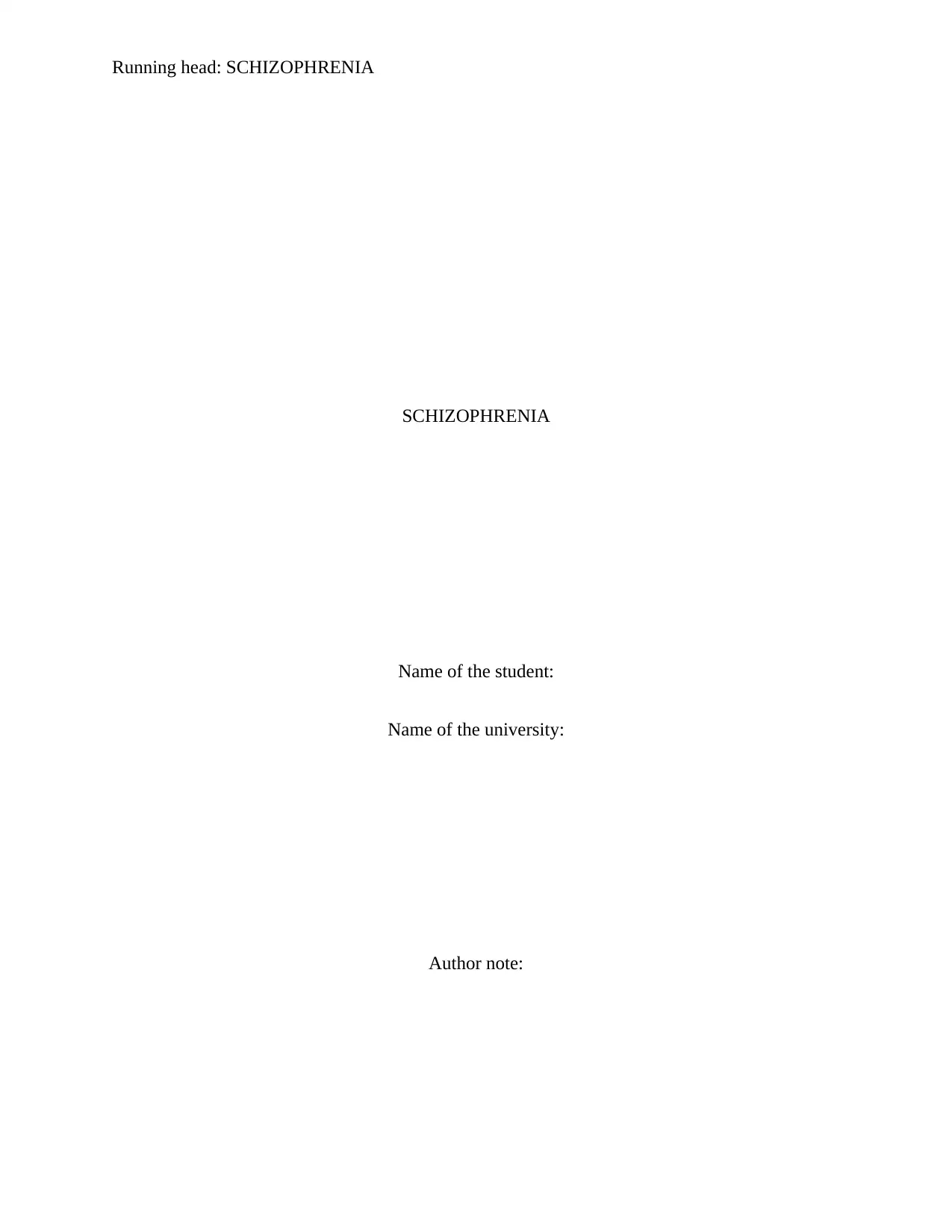
Running head: SCHIZOPHRENIA
SCHIZOPHRENIA
Name of the student:
Name of the university:
Author note:
SCHIZOPHRENIA
Name of the student:
Name of the university:
Author note:
Paraphrase This Document
Need a fresh take? Get an instant paraphrase of this document with our AI Paraphraser
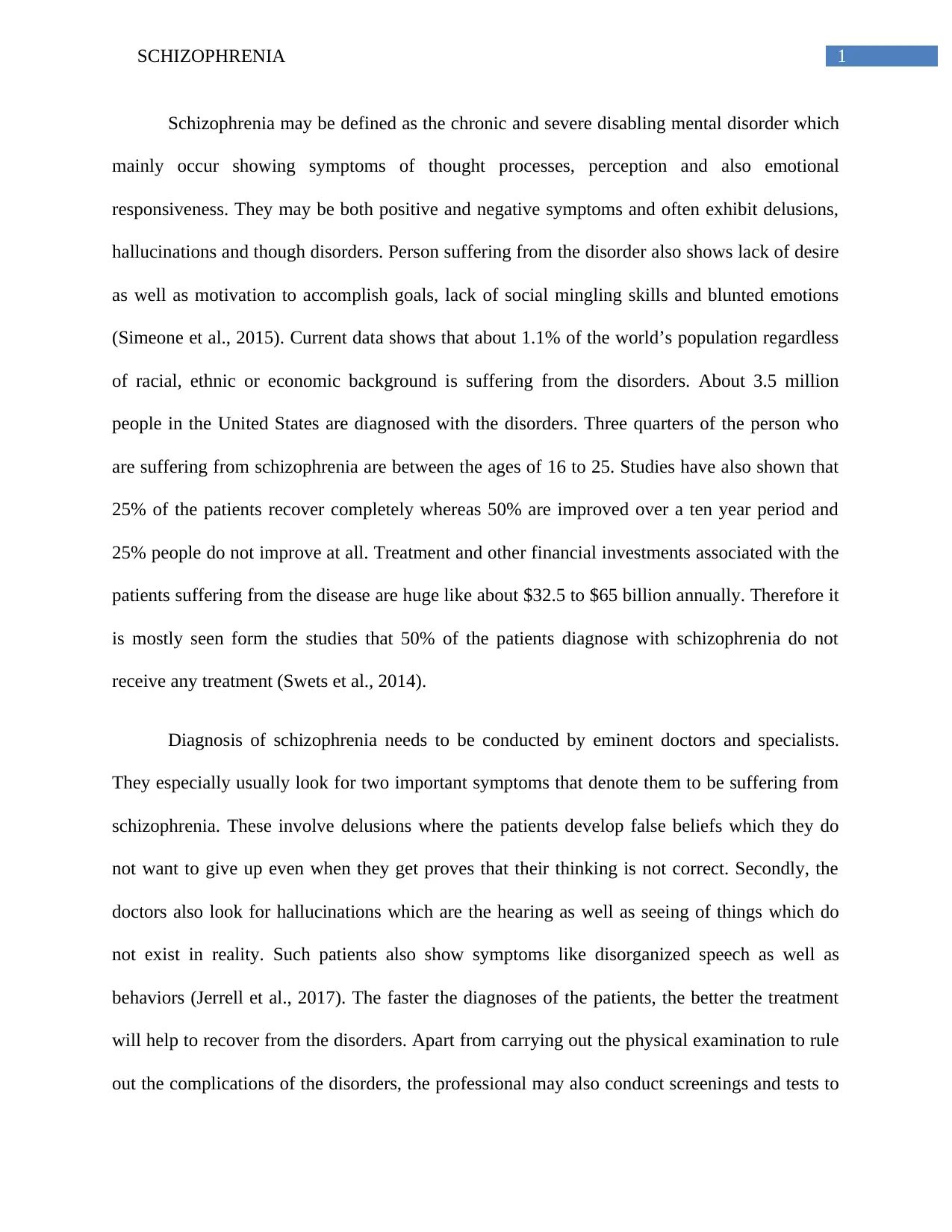
1SCHIZOPHRENIA
Schizophrenia may be defined as the chronic and severe disabling mental disorder which
mainly occur showing symptoms of thought processes, perception and also emotional
responsiveness. They may be both positive and negative symptoms and often exhibit delusions,
hallucinations and though disorders. Person suffering from the disorder also shows lack of desire
as well as motivation to accomplish goals, lack of social mingling skills and blunted emotions
(Simeone et al., 2015). Current data shows that about 1.1% of the world’s population regardless
of racial, ethnic or economic background is suffering from the disorders. About 3.5 million
people in the United States are diagnosed with the disorders. Three quarters of the person who
are suffering from schizophrenia are between the ages of 16 to 25. Studies have also shown that
25% of the patients recover completely whereas 50% are improved over a ten year period and
25% people do not improve at all. Treatment and other financial investments associated with the
patients suffering from the disease are huge like about $32.5 to $65 billion annually. Therefore it
is mostly seen form the studies that 50% of the patients diagnose with schizophrenia do not
receive any treatment (Swets et al., 2014).
Diagnosis of schizophrenia needs to be conducted by eminent doctors and specialists.
They especially usually look for two important symptoms that denote them to be suffering from
schizophrenia. These involve delusions where the patients develop false beliefs which they do
not want to give up even when they get proves that their thinking is not correct. Secondly, the
doctors also look for hallucinations which are the hearing as well as seeing of things which do
not exist in reality. Such patients also show symptoms like disorganized speech as well as
behaviors (Jerrell et al., 2017). The faster the diagnoses of the patients, the better the treatment
will help to recover from the disorders. Apart from carrying out the physical examination to rule
out the complications of the disorders, the professional may also conduct screenings and tests to
Schizophrenia may be defined as the chronic and severe disabling mental disorder which
mainly occur showing symptoms of thought processes, perception and also emotional
responsiveness. They may be both positive and negative symptoms and often exhibit delusions,
hallucinations and though disorders. Person suffering from the disorder also shows lack of desire
as well as motivation to accomplish goals, lack of social mingling skills and blunted emotions
(Simeone et al., 2015). Current data shows that about 1.1% of the world’s population regardless
of racial, ethnic or economic background is suffering from the disorders. About 3.5 million
people in the United States are diagnosed with the disorders. Three quarters of the person who
are suffering from schizophrenia are between the ages of 16 to 25. Studies have also shown that
25% of the patients recover completely whereas 50% are improved over a ten year period and
25% people do not improve at all. Treatment and other financial investments associated with the
patients suffering from the disease are huge like about $32.5 to $65 billion annually. Therefore it
is mostly seen form the studies that 50% of the patients diagnose with schizophrenia do not
receive any treatment (Swets et al., 2014).
Diagnosis of schizophrenia needs to be conducted by eminent doctors and specialists.
They especially usually look for two important symptoms that denote them to be suffering from
schizophrenia. These involve delusions where the patients develop false beliefs which they do
not want to give up even when they get proves that their thinking is not correct. Secondly, the
doctors also look for hallucinations which are the hearing as well as seeing of things which do
not exist in reality. Such patients also show symptoms like disorganized speech as well as
behaviors (Jerrell et al., 2017). The faster the diagnoses of the patients, the better the treatment
will help to recover from the disorders. Apart from carrying out the physical examination to rule
out the complications of the disorders, the professional may also conduct screenings and tests to
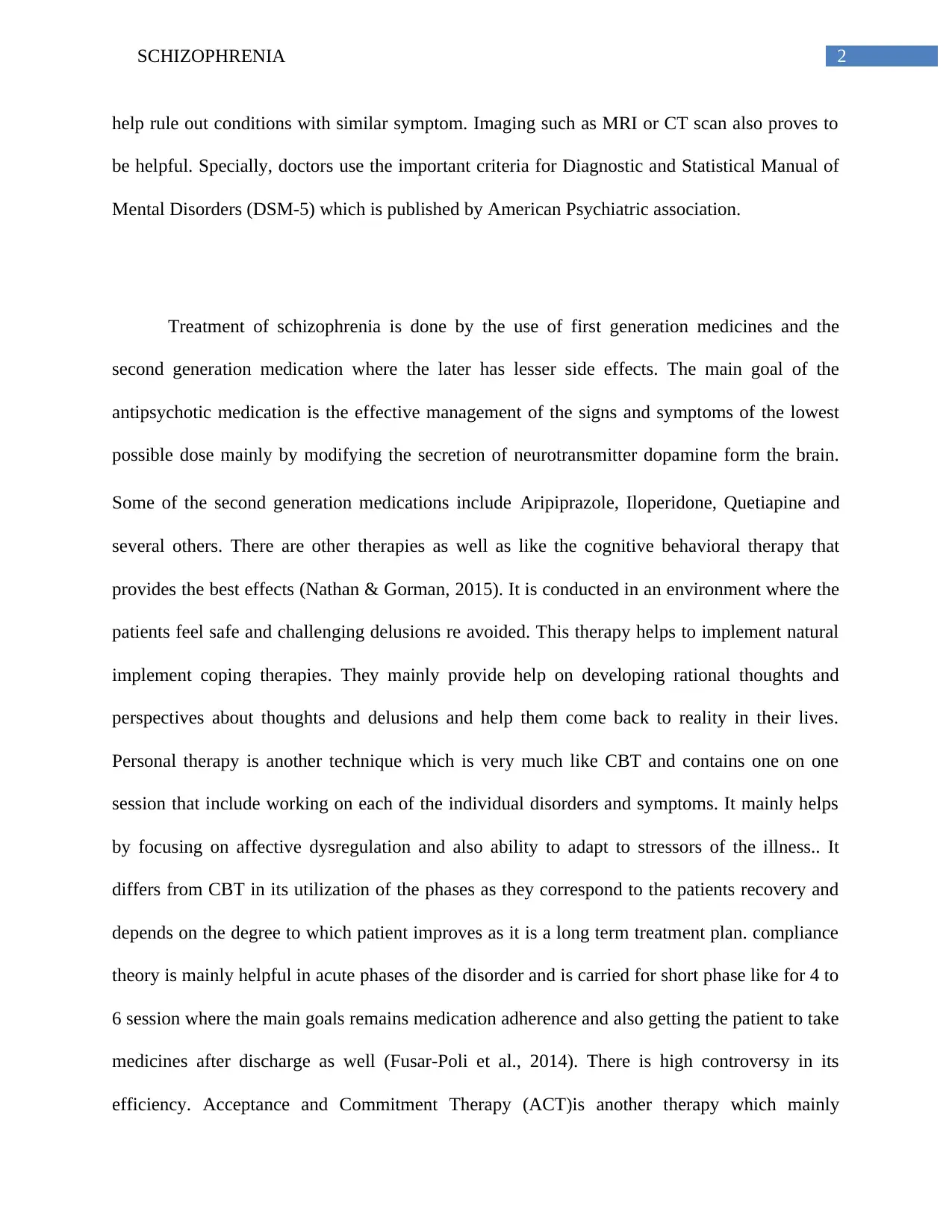
2SCHIZOPHRENIA
help rule out conditions with similar symptom. Imaging such as MRI or CT scan also proves to
be helpful. Specially, doctors use the important criteria for Diagnostic and Statistical Manual of
Mental Disorders (DSM-5) which is published by American Psychiatric association.
Treatment of schizophrenia is done by the use of first generation medicines and the
second generation medication where the later has lesser side effects. The main goal of the
antipsychotic medication is the effective management of the signs and symptoms of the lowest
possible dose mainly by modifying the secretion of neurotransmitter dopamine form the brain.
Some of the second generation medications include Aripiprazole, Iloperidone, Quetiapine and
several others. There are other therapies as well as like the cognitive behavioral therapy that
provides the best effects (Nathan & Gorman, 2015). It is conducted in an environment where the
patients feel safe and challenging delusions re avoided. This therapy helps to implement natural
implement coping therapies. They mainly provide help on developing rational thoughts and
perspectives about thoughts and delusions and help them come back to reality in their lives.
Personal therapy is another technique which is very much like CBT and contains one on one
session that include working on each of the individual disorders and symptoms. It mainly helps
by focusing on affective dysregulation and also ability to adapt to stressors of the illness.. It
differs from CBT in its utilization of the phases as they correspond to the patients recovery and
depends on the degree to which patient improves as it is a long term treatment plan. compliance
theory is mainly helpful in acute phases of the disorder and is carried for short phase like for 4 to
6 session where the main goals remains medication adherence and also getting the patient to take
medicines after discharge as well (Fusar-Poli et al., 2014). There is high controversy in its
efficiency. Acceptance and Commitment Therapy (ACT)is another therapy which mainly
help rule out conditions with similar symptom. Imaging such as MRI or CT scan also proves to
be helpful. Specially, doctors use the important criteria for Diagnostic and Statistical Manual of
Mental Disorders (DSM-5) which is published by American Psychiatric association.
Treatment of schizophrenia is done by the use of first generation medicines and the
second generation medication where the later has lesser side effects. The main goal of the
antipsychotic medication is the effective management of the signs and symptoms of the lowest
possible dose mainly by modifying the secretion of neurotransmitter dopamine form the brain.
Some of the second generation medications include Aripiprazole, Iloperidone, Quetiapine and
several others. There are other therapies as well as like the cognitive behavioral therapy that
provides the best effects (Nathan & Gorman, 2015). It is conducted in an environment where the
patients feel safe and challenging delusions re avoided. This therapy helps to implement natural
implement coping therapies. They mainly provide help on developing rational thoughts and
perspectives about thoughts and delusions and help them come back to reality in their lives.
Personal therapy is another technique which is very much like CBT and contains one on one
session that include working on each of the individual disorders and symptoms. It mainly helps
by focusing on affective dysregulation and also ability to adapt to stressors of the illness.. It
differs from CBT in its utilization of the phases as they correspond to the patients recovery and
depends on the degree to which patient improves as it is a long term treatment plan. compliance
theory is mainly helpful in acute phases of the disorder and is carried for short phase like for 4 to
6 session where the main goals remains medication adherence and also getting the patient to take
medicines after discharge as well (Fusar-Poli et al., 2014). There is high controversy in its
efficiency. Acceptance and Commitment Therapy (ACT)is another therapy which mainly
⊘ This is a preview!⊘
Do you want full access?
Subscribe today to unlock all pages.

Trusted by 1+ million students worldwide
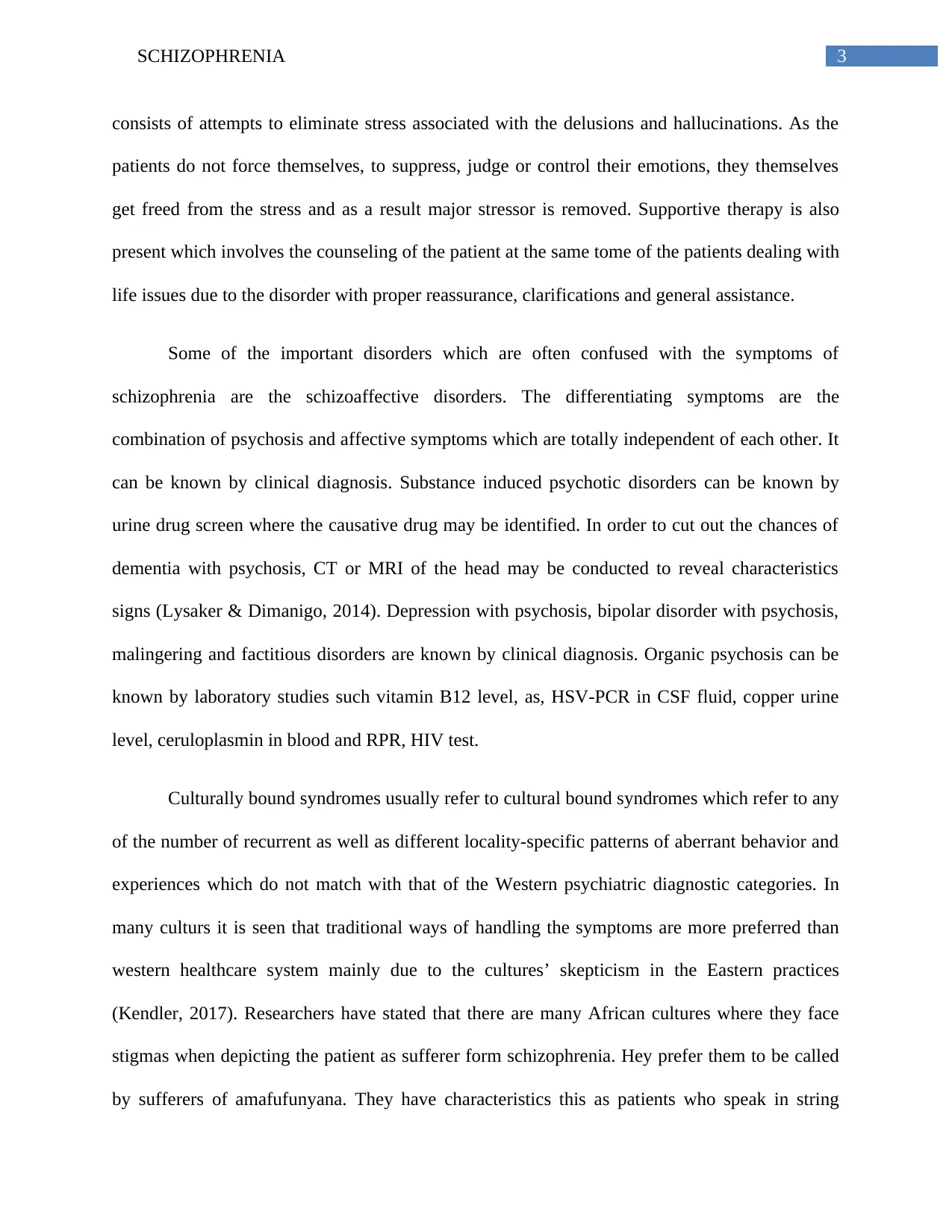
3SCHIZOPHRENIA
consists of attempts to eliminate stress associated with the delusions and hallucinations. As the
patients do not force themselves, to suppress, judge or control their emotions, they themselves
get freed from the stress and as a result major stressor is removed. Supportive therapy is also
present which involves the counseling of the patient at the same tome of the patients dealing with
life issues due to the disorder with proper reassurance, clarifications and general assistance.
Some of the important disorders which are often confused with the symptoms of
schizophrenia are the schizoaffective disorders. The differentiating symptoms are the
combination of psychosis and affective symptoms which are totally independent of each other. It
can be known by clinical diagnosis. Substance induced psychotic disorders can be known by
urine drug screen where the causative drug may be identified. In order to cut out the chances of
dementia with psychosis, CT or MRI of the head may be conducted to reveal characteristics
signs (Lysaker & Dimanigo, 2014). Depression with psychosis, bipolar disorder with psychosis,
malingering and factitious disorders are known by clinical diagnosis. Organic psychosis can be
known by laboratory studies such vitamin B12 level, as, HSV-PCR in CSF fluid, copper urine
level, ceruloplasmin in blood and RPR, HIV test.
Culturally bound syndromes usually refer to cultural bound syndromes which refer to any
of the number of recurrent as well as different locality-specific patterns of aberrant behavior and
experiences which do not match with that of the Western psychiatric diagnostic categories. In
many culturs it is seen that traditional ways of handling the symptoms are more preferred than
western healthcare system mainly due to the cultures’ skepticism in the Eastern practices
(Kendler, 2017). Researchers have stated that there are many African cultures where they face
stigmas when depicting the patient as sufferer form schizophrenia. Hey prefer them to be called
by sufferers of amafufunyana. They have characteristics this as patients who speak in string
consists of attempts to eliminate stress associated with the delusions and hallucinations. As the
patients do not force themselves, to suppress, judge or control their emotions, they themselves
get freed from the stress and as a result major stressor is removed. Supportive therapy is also
present which involves the counseling of the patient at the same tome of the patients dealing with
life issues due to the disorder with proper reassurance, clarifications and general assistance.
Some of the important disorders which are often confused with the symptoms of
schizophrenia are the schizoaffective disorders. The differentiating symptoms are the
combination of psychosis and affective symptoms which are totally independent of each other. It
can be known by clinical diagnosis. Substance induced psychotic disorders can be known by
urine drug screen where the causative drug may be identified. In order to cut out the chances of
dementia with psychosis, CT or MRI of the head may be conducted to reveal characteristics
signs (Lysaker & Dimanigo, 2014). Depression with psychosis, bipolar disorder with psychosis,
malingering and factitious disorders are known by clinical diagnosis. Organic psychosis can be
known by laboratory studies such vitamin B12 level, as, HSV-PCR in CSF fluid, copper urine
level, ceruloplasmin in blood and RPR, HIV test.
Culturally bound syndromes usually refer to cultural bound syndromes which refer to any
of the number of recurrent as well as different locality-specific patterns of aberrant behavior and
experiences which do not match with that of the Western psychiatric diagnostic categories. In
many culturs it is seen that traditional ways of handling the symptoms are more preferred than
western healthcare system mainly due to the cultures’ skepticism in the Eastern practices
(Kendler, 2017). Researchers have stated that there are many African cultures where they face
stigmas when depicting the patient as sufferer form schizophrenia. Hey prefer them to be called
by sufferers of amafufunyana. They have characteristics this as patients who speak in string
Paraphrase This Document
Need a fresh take? Get an instant paraphrase of this document with our AI Paraphraser
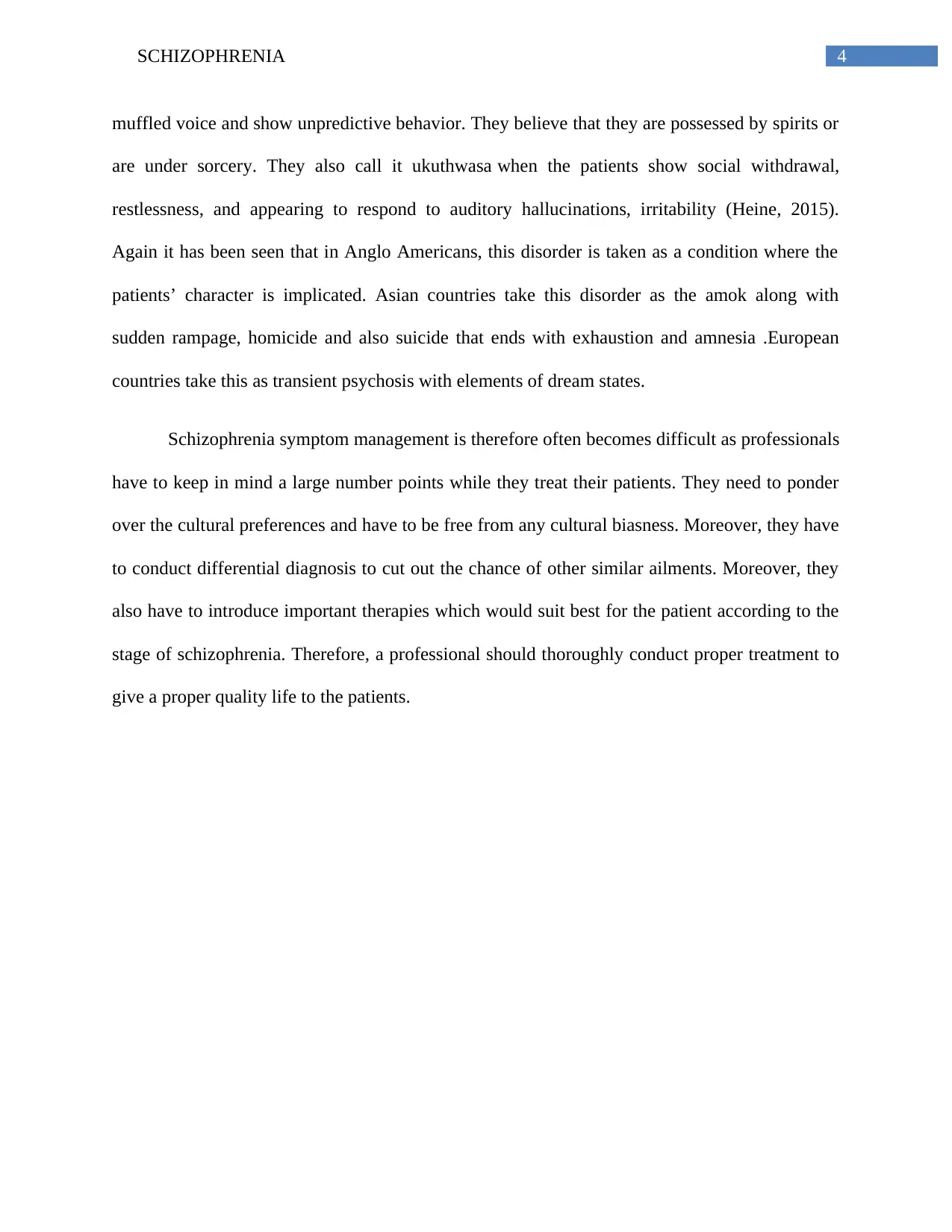
4SCHIZOPHRENIA
muffled voice and show unpredictive behavior. They believe that they are possessed by spirits or
are under sorcery. They also call it ukuthwasa when the patients show social withdrawal,
restlessness, and appearing to respond to auditory hallucinations, irritability (Heine, 2015).
Again it has been seen that in Anglo Americans, this disorder is taken as a condition where the
patients’ character is implicated. Asian countries take this disorder as the amok along with
sudden rampage, homicide and also suicide that ends with exhaustion and amnesia .European
countries take this as transient psychosis with elements of dream states.
Schizophrenia symptom management is therefore often becomes difficult as professionals
have to keep in mind a large number points while they treat their patients. They need to ponder
over the cultural preferences and have to be free from any cultural biasness. Moreover, they have
to conduct differential diagnosis to cut out the chance of other similar ailments. Moreover, they
also have to introduce important therapies which would suit best for the patient according to the
stage of schizophrenia. Therefore, a professional should thoroughly conduct proper treatment to
give a proper quality life to the patients.
muffled voice and show unpredictive behavior. They believe that they are possessed by spirits or
are under sorcery. They also call it ukuthwasa when the patients show social withdrawal,
restlessness, and appearing to respond to auditory hallucinations, irritability (Heine, 2015).
Again it has been seen that in Anglo Americans, this disorder is taken as a condition where the
patients’ character is implicated. Asian countries take this disorder as the amok along with
sudden rampage, homicide and also suicide that ends with exhaustion and amnesia .European
countries take this as transient psychosis with elements of dream states.
Schizophrenia symptom management is therefore often becomes difficult as professionals
have to keep in mind a large number points while they treat their patients. They need to ponder
over the cultural preferences and have to be free from any cultural biasness. Moreover, they have
to conduct differential diagnosis to cut out the chance of other similar ailments. Moreover, they
also have to introduce important therapies which would suit best for the patient according to the
stage of schizophrenia. Therefore, a professional should thoroughly conduct proper treatment to
give a proper quality life to the patients.
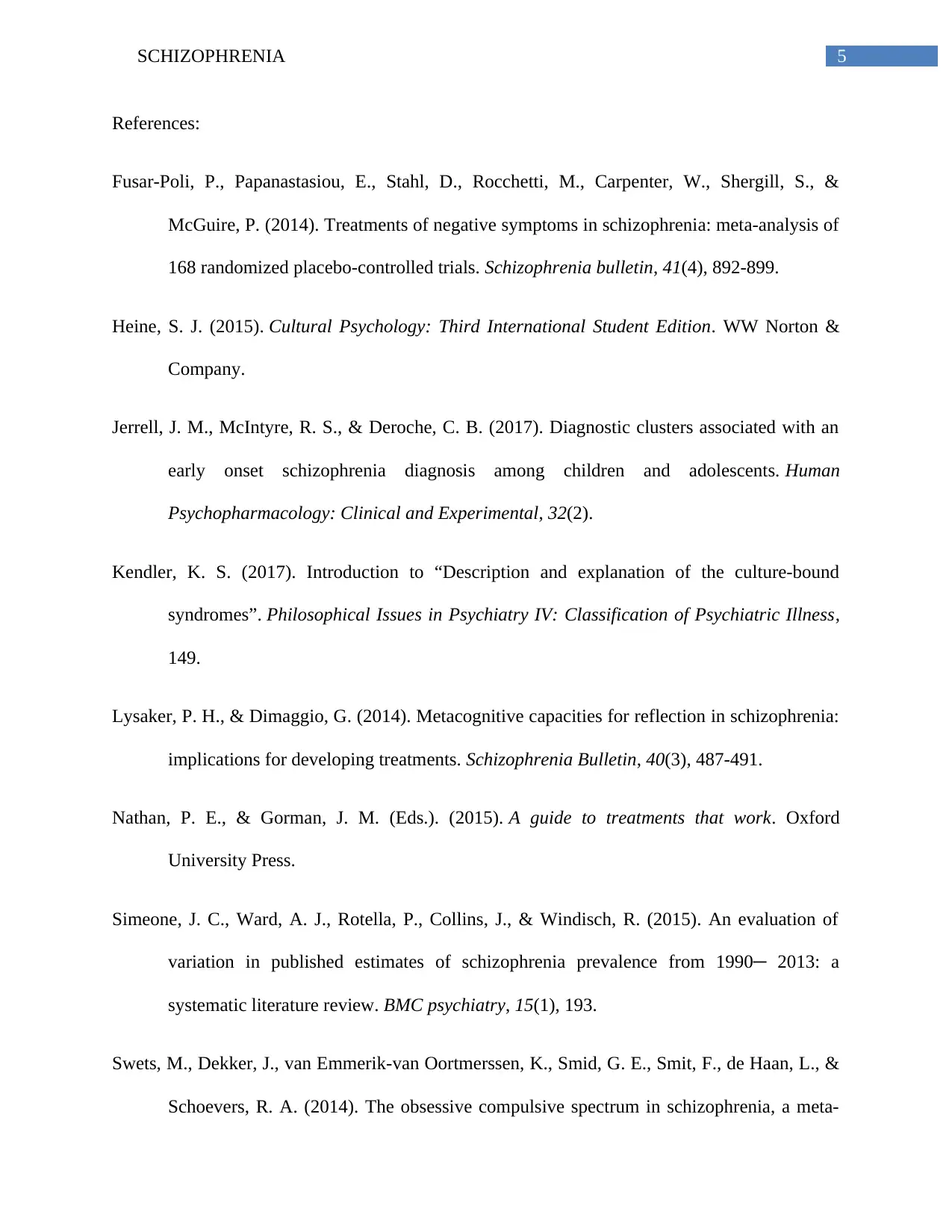
5SCHIZOPHRENIA
References:
Fusar-Poli, P., Papanastasiou, E., Stahl, D., Rocchetti, M., Carpenter, W., Shergill, S., &
McGuire, P. (2014). Treatments of negative symptoms in schizophrenia: meta-analysis of
168 randomized placebo-controlled trials. Schizophrenia bulletin, 41(4), 892-899.
Heine, S. J. (2015). Cultural Psychology: Third International Student Edition. WW Norton &
Company.
Jerrell, J. M., McIntyre, R. S., & Deroche, C. B. (2017). Diagnostic clusters associated with an
early onset schizophrenia diagnosis among children and adolescents. Human
Psychopharmacology: Clinical and Experimental, 32(2).
Kendler, K. S. (2017). Introduction to “Description and explanation of the culture-bound
syndromes”. Philosophical Issues in Psychiatry IV: Classification of Psychiatric Illness,
149.
Lysaker, P. H., & Dimaggio, G. (2014). Metacognitive capacities for reflection in schizophrenia:
implications for developing treatments. Schizophrenia Bulletin, 40(3), 487-491.
Nathan, P. E., & Gorman, J. M. (Eds.). (2015). A guide to treatments that work. Oxford
University Press.
Simeone, J. C., Ward, A. J., Rotella, P., Collins, J., & Windisch, R. (2015). An evaluation of
variation in published estimates of schizophrenia prevalence from 1990─ 2013: a
systematic literature review. BMC psychiatry, 15(1), 193.
Swets, M., Dekker, J., van Emmerik-van Oortmerssen, K., Smid, G. E., Smit, F., de Haan, L., &
Schoevers, R. A. (2014). The obsessive compulsive spectrum in schizophrenia, a meta-
References:
Fusar-Poli, P., Papanastasiou, E., Stahl, D., Rocchetti, M., Carpenter, W., Shergill, S., &
McGuire, P. (2014). Treatments of negative symptoms in schizophrenia: meta-analysis of
168 randomized placebo-controlled trials. Schizophrenia bulletin, 41(4), 892-899.
Heine, S. J. (2015). Cultural Psychology: Third International Student Edition. WW Norton &
Company.
Jerrell, J. M., McIntyre, R. S., & Deroche, C. B. (2017). Diagnostic clusters associated with an
early onset schizophrenia diagnosis among children and adolescents. Human
Psychopharmacology: Clinical and Experimental, 32(2).
Kendler, K. S. (2017). Introduction to “Description and explanation of the culture-bound
syndromes”. Philosophical Issues in Psychiatry IV: Classification of Psychiatric Illness,
149.
Lysaker, P. H., & Dimaggio, G. (2014). Metacognitive capacities for reflection in schizophrenia:
implications for developing treatments. Schizophrenia Bulletin, 40(3), 487-491.
Nathan, P. E., & Gorman, J. M. (Eds.). (2015). A guide to treatments that work. Oxford
University Press.
Simeone, J. C., Ward, A. J., Rotella, P., Collins, J., & Windisch, R. (2015). An evaluation of
variation in published estimates of schizophrenia prevalence from 1990─ 2013: a
systematic literature review. BMC psychiatry, 15(1), 193.
Swets, M., Dekker, J., van Emmerik-van Oortmerssen, K., Smid, G. E., Smit, F., de Haan, L., &
Schoevers, R. A. (2014). The obsessive compulsive spectrum in schizophrenia, a meta-
⊘ This is a preview!⊘
Do you want full access?
Subscribe today to unlock all pages.

Trusted by 1+ million students worldwide
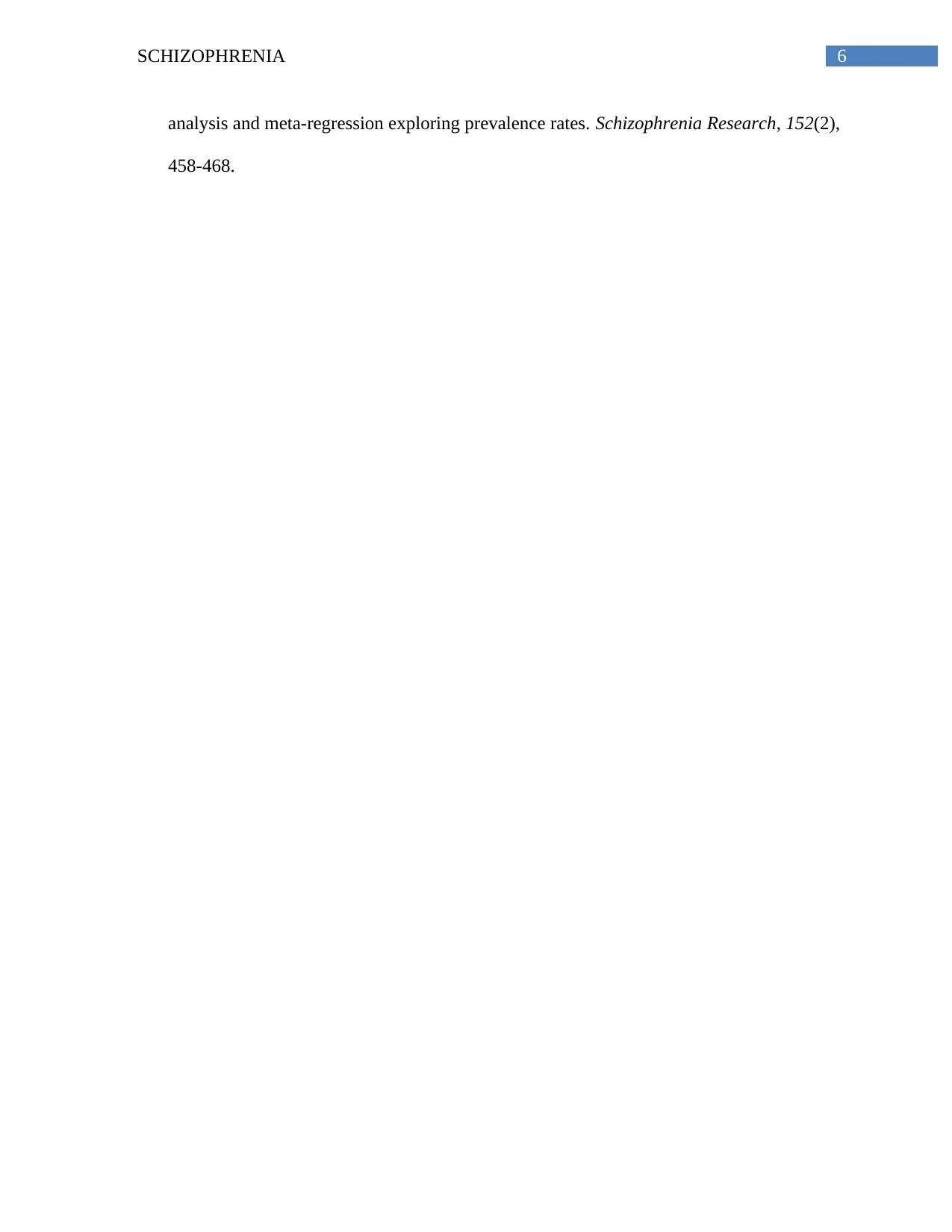
6SCHIZOPHRENIA
analysis and meta-regression exploring prevalence rates. Schizophrenia Research, 152(2),
458-468.
analysis and meta-regression exploring prevalence rates. Schizophrenia Research, 152(2),
458-468.
Paraphrase This Document
Need a fresh take? Get an instant paraphrase of this document with our AI Paraphraser
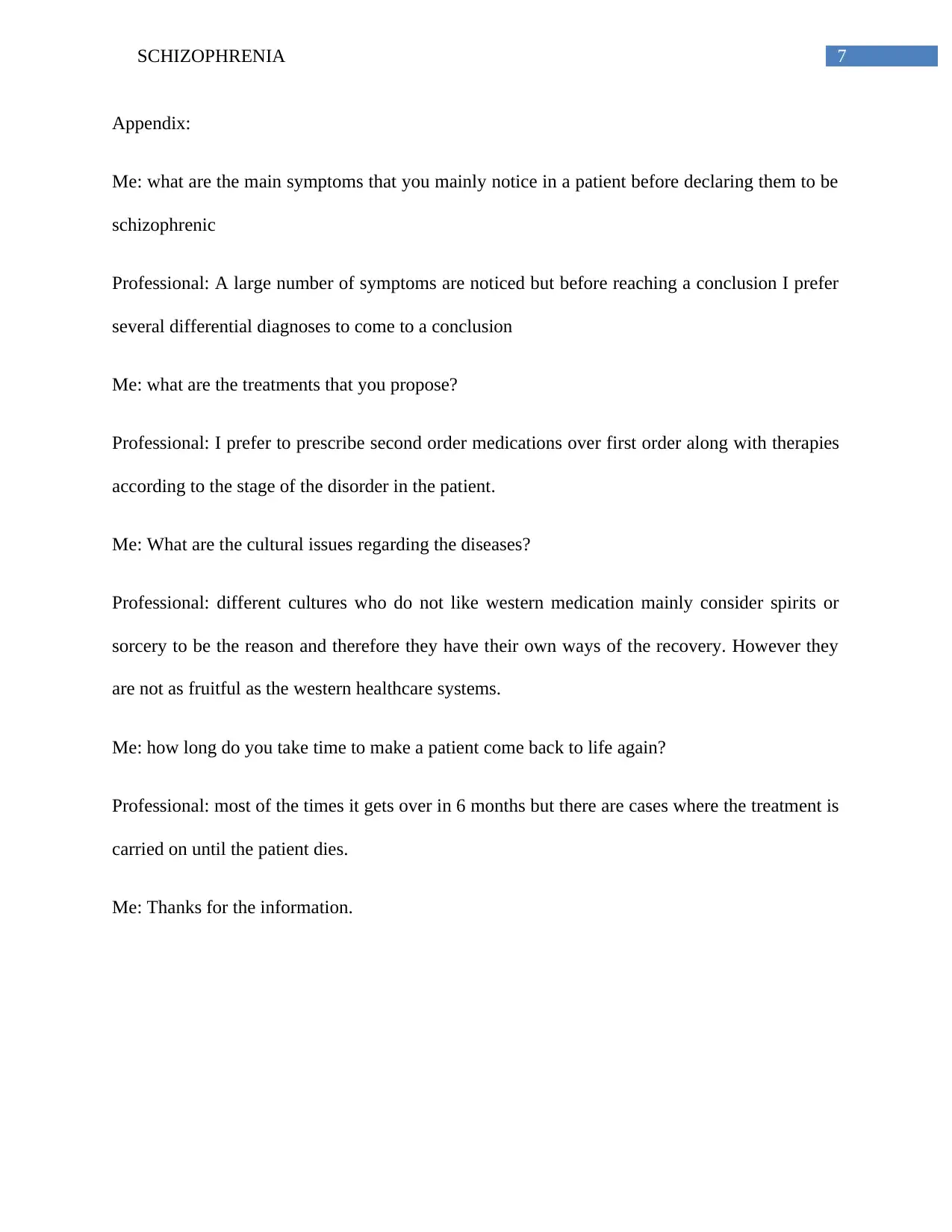
7SCHIZOPHRENIA
Appendix:
Me: what are the main symptoms that you mainly notice in a patient before declaring them to be
schizophrenic
Professional: A large number of symptoms are noticed but before reaching a conclusion I prefer
several differential diagnoses to come to a conclusion
Me: what are the treatments that you propose?
Professional: I prefer to prescribe second order medications over first order along with therapies
according to the stage of the disorder in the patient.
Me: What are the cultural issues regarding the diseases?
Professional: different cultures who do not like western medication mainly consider spirits or
sorcery to be the reason and therefore they have their own ways of the recovery. However they
are not as fruitful as the western healthcare systems.
Me: how long do you take time to make a patient come back to life again?
Professional: most of the times it gets over in 6 months but there are cases where the treatment is
carried on until the patient dies.
Me: Thanks for the information.
Appendix:
Me: what are the main symptoms that you mainly notice in a patient before declaring them to be
schizophrenic
Professional: A large number of symptoms are noticed but before reaching a conclusion I prefer
several differential diagnoses to come to a conclusion
Me: what are the treatments that you propose?
Professional: I prefer to prescribe second order medications over first order along with therapies
according to the stage of the disorder in the patient.
Me: What are the cultural issues regarding the diseases?
Professional: different cultures who do not like western medication mainly consider spirits or
sorcery to be the reason and therefore they have their own ways of the recovery. However they
are not as fruitful as the western healthcare systems.
Me: how long do you take time to make a patient come back to life again?
Professional: most of the times it gets over in 6 months but there are cases where the treatment is
carried on until the patient dies.
Me: Thanks for the information.
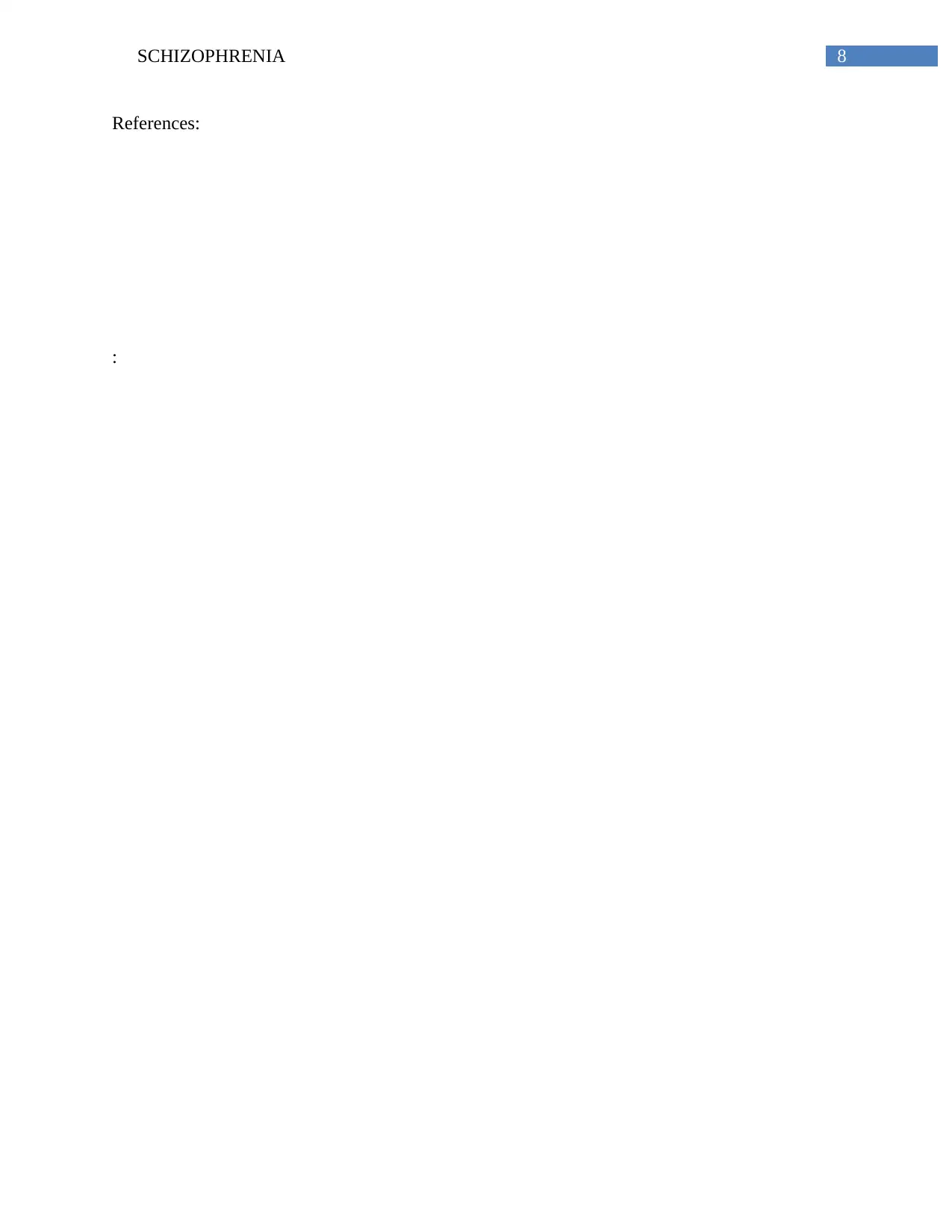
8SCHIZOPHRENIA
References:
:
References:
:
⊘ This is a preview!⊘
Do you want full access?
Subscribe today to unlock all pages.

Trusted by 1+ million students worldwide
1 out of 9
Related Documents
Your All-in-One AI-Powered Toolkit for Academic Success.
+13062052269
info@desklib.com
Available 24*7 on WhatsApp / Email
![[object Object]](/_next/static/media/star-bottom.7253800d.svg)
Unlock your academic potential
Copyright © 2020–2025 A2Z Services. All Rights Reserved. Developed and managed by ZUCOL.





